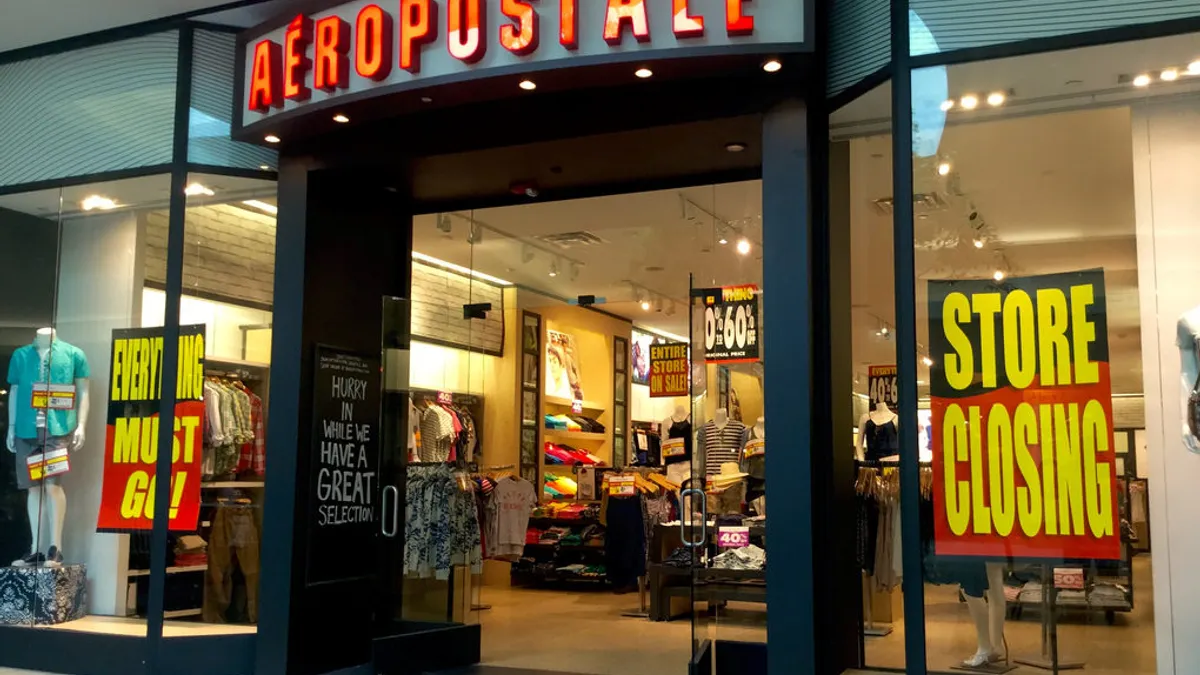Dive Brief:
-
David Simon, chairman and CEO of No. 1 mall developer Simon Property Group said in a call with investors that struggling teen retailer Aeropostale could grow back to 500 profitable stores, a fleet the retailer hasn't seen since it's pre-bankruptcy days.
-
Aeropostale was bought by a group of investors including Simon in a September bankruptcy auction for $243 million. “[T]he only reason we decided to make this investment is because we believe we can make money," Simon said. "If our model is right, we think we’re buying this company at one to two times EBITDA with future growth opportunities ahead of it.”
-
But, the move to buy out a struggling tenant will not become a habit, Simon said. “Aeropostale is a great example of our ability to analyze what the right trade is in these deals,” he said, according to a transcript of the call. “[I]n some cases, we’re going to take the space back, in other cases we’re going to help the retailer go through the hard time. … But there is nobody I think in our industry that’s more sophisticated in our ability to kind of maneuver through those situations."
Dive Insight:
In September, landlords Simon Property Group and General Growth Properties, along with liquidators Gordon Brothers Retail Partners LLC and Hilco Merchant Resources LLC, and licensing firm Authentic Brands Group, won Aeropostale in a bankruptcy auction with the aim to keep the retailer alive as a 240-store chain. But, before the teen retailer filed for bankruptcy in May, it boasted over 800 stores, and Simon has hope that Aeropostale will bounce back from its slimmed-down footprint.
Not everyone was so optimistic. Before the investor lifeline, the retailer seemed to be nearing its end, as investor Sycamore Partners was poised to leverage its loan to take over operations. Sycamore has been a thorn in Aeropostale’s side ever since the retailer sold a major stake to Sycamore in 2014. That deal, which included an agreement to source with Sycamore-owned clothing manufacturer and supply chain management company MGF, is a major reason Aeropostale wound up on the brink of collapse, at least according to the retail chain’s version of events. Sycamore argues that mismanagement, not its sourcing stipulations, is to blame.
Speaking with investors last week, Simon sought to clarify that the $243 million bid for the retailer was the total outlay that included inventory that’s being scooped up by members of the consortium, and not the actual purchase price for the retailer’s operations. “I want you to understand that $188 million of that is inventory being purchased by Hilco and Gordon Brothers and not by our buying group,” he said. “Our initial investment is approximately $55 million by the group of which our share is $33 million, including working capital.”
Simon's vote of confidence has the retailer poised for a comeback, but Aeropostale's turnaround will call for an overhaul of the strategies that landed it in bankruptcy. For instance, experts say it will need to shift away from logo-centric clothing that is no longer in fashion and understand that its purported customer base, tweens, aren't the ones footing the bill — it's their parents.
"Today Aero is all about price. They have this kind of junior customer who's not quite a fast-fashion customer, where Mom’s the real shopper, taking the 11-year-old into the store. So if that trend is off or too sexy for this kid, Mom’s not going to be buying that," Shelley E. Kohan, VP of retail consulting at store analytics firm RetailNext, told Retail Dive earlier this year. "I think they’re missing the trend for that market."














